Quality Management for Organisational Excellence: QTC Analysis
VerifiedAdded on 2023/01/12
|13
|3905
|30
Report
AI Summary
This report delves into the realm of quality management, with a specific focus on achieving organizational excellence. It begins by defining quality and its significance, particularly within the context of the Quality Tooling Company (QTC), a firm involved in manufacturing engineering and medical equipment. The main body of the report explores key concepts such as Total Quality Management (TQM), its principles (customer satisfaction, employee commitment, fact-based decision making, effective communication, strategic thinking, integrated systems, process-centered, and continuous improvement), and its practical application through the Plan-Do-Check-Act (PDCA) cycle. Furthermore, the report addresses Quality Assurance (QA) methodologies, including statistical process control, failure testing, and the role of TQM. It also examines the importance of ISO 9000 standards in fostering international trade and maintaining quality. The report concludes with recommendations for QTC, emphasizing the need for strategic adaptation to ensure long-term survival and success.
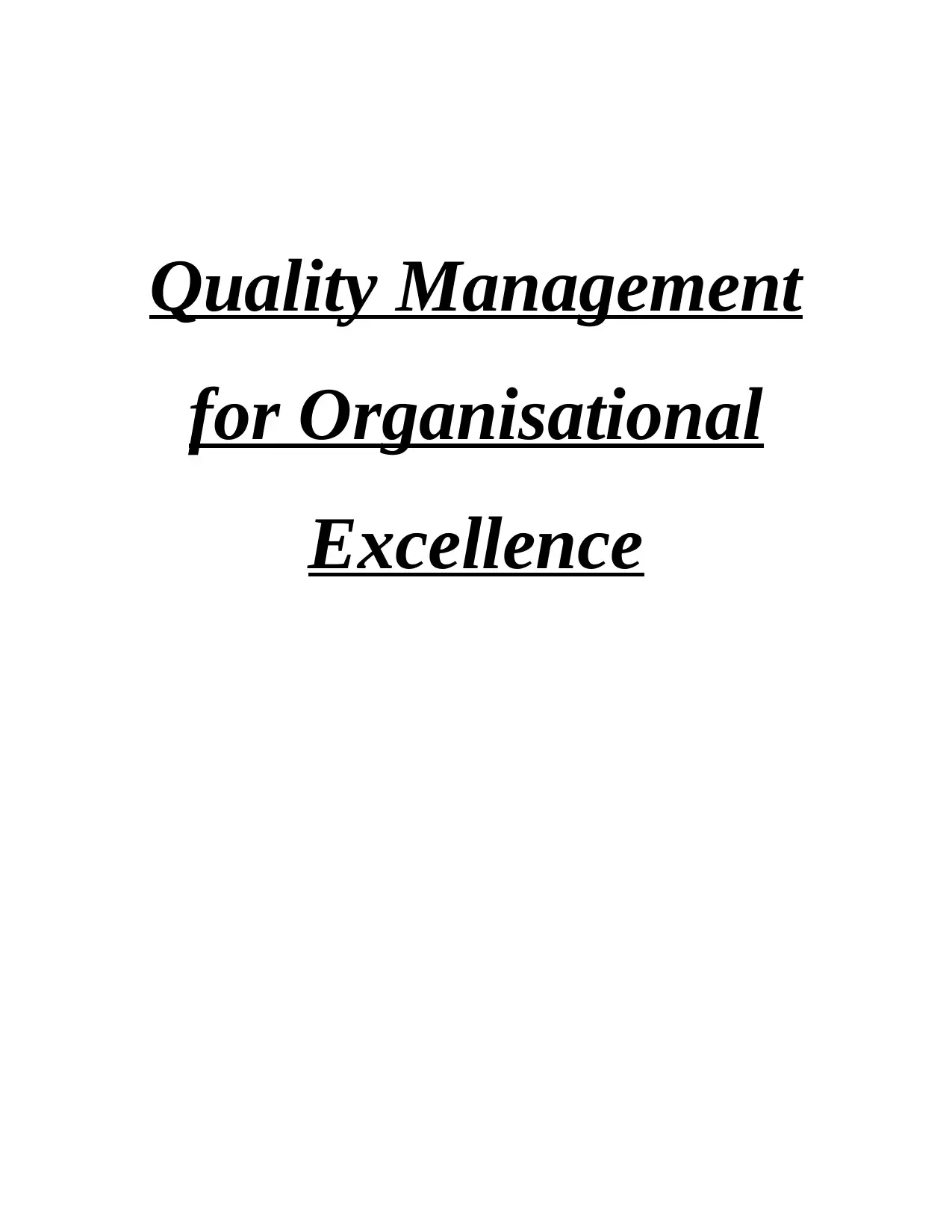
Quality Management
for Organisational
Excellence
for Organisational
Excellence
Paraphrase This Document
Need a fresh take? Get an instant paraphrase of this document with our AI Paraphraser
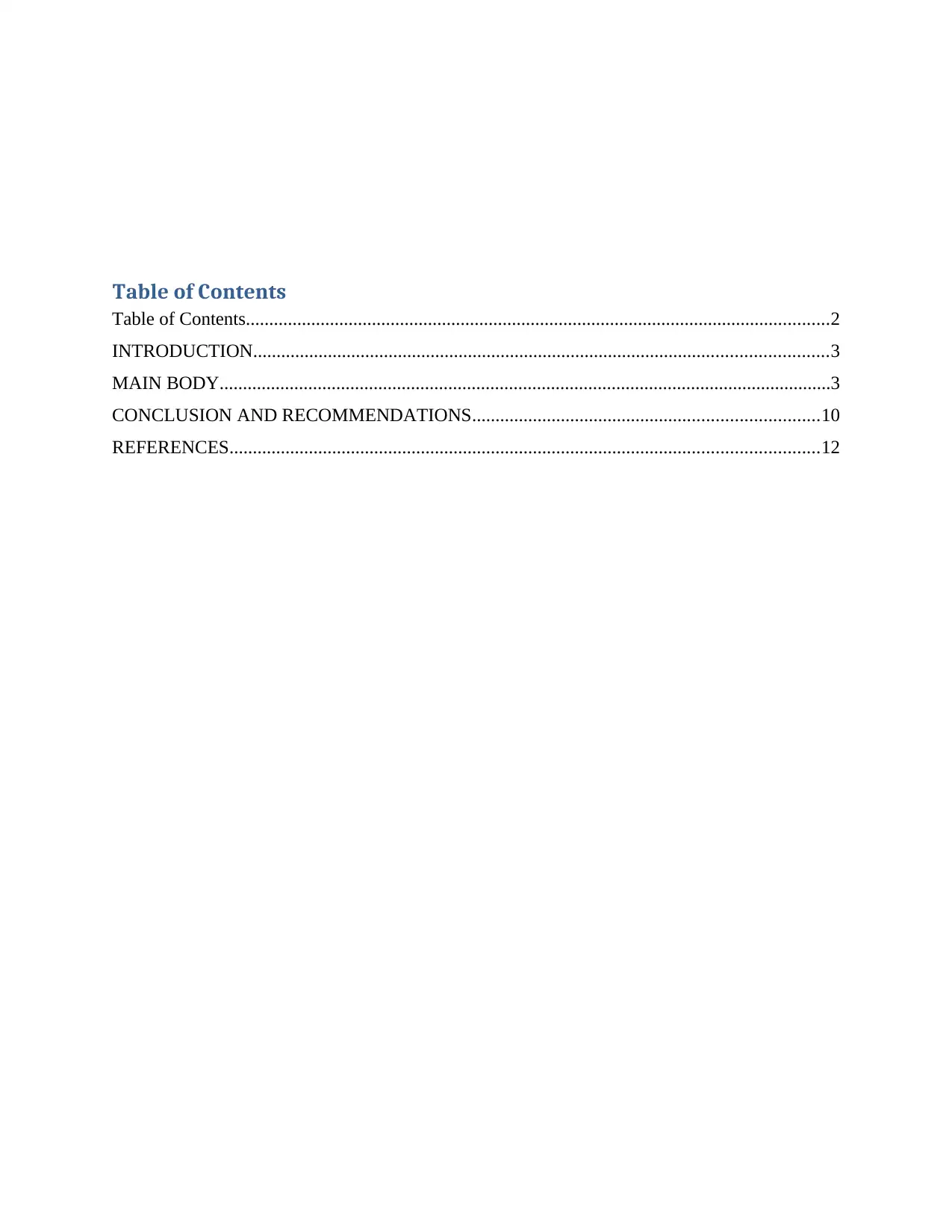
Table of Contents
Table of Contents.............................................................................................................................2
INTRODUCTION...........................................................................................................................3
MAIN BODY...................................................................................................................................3
CONCLUSION AND RECOMMENDATIONS..........................................................................10
REFERENCES..............................................................................................................................12
Table of Contents.............................................................................................................................2
INTRODUCTION...........................................................................................................................3
MAIN BODY...................................................................................................................................3
CONCLUSION AND RECOMMENDATIONS..........................................................................10
REFERENCES..............................................................................................................................12
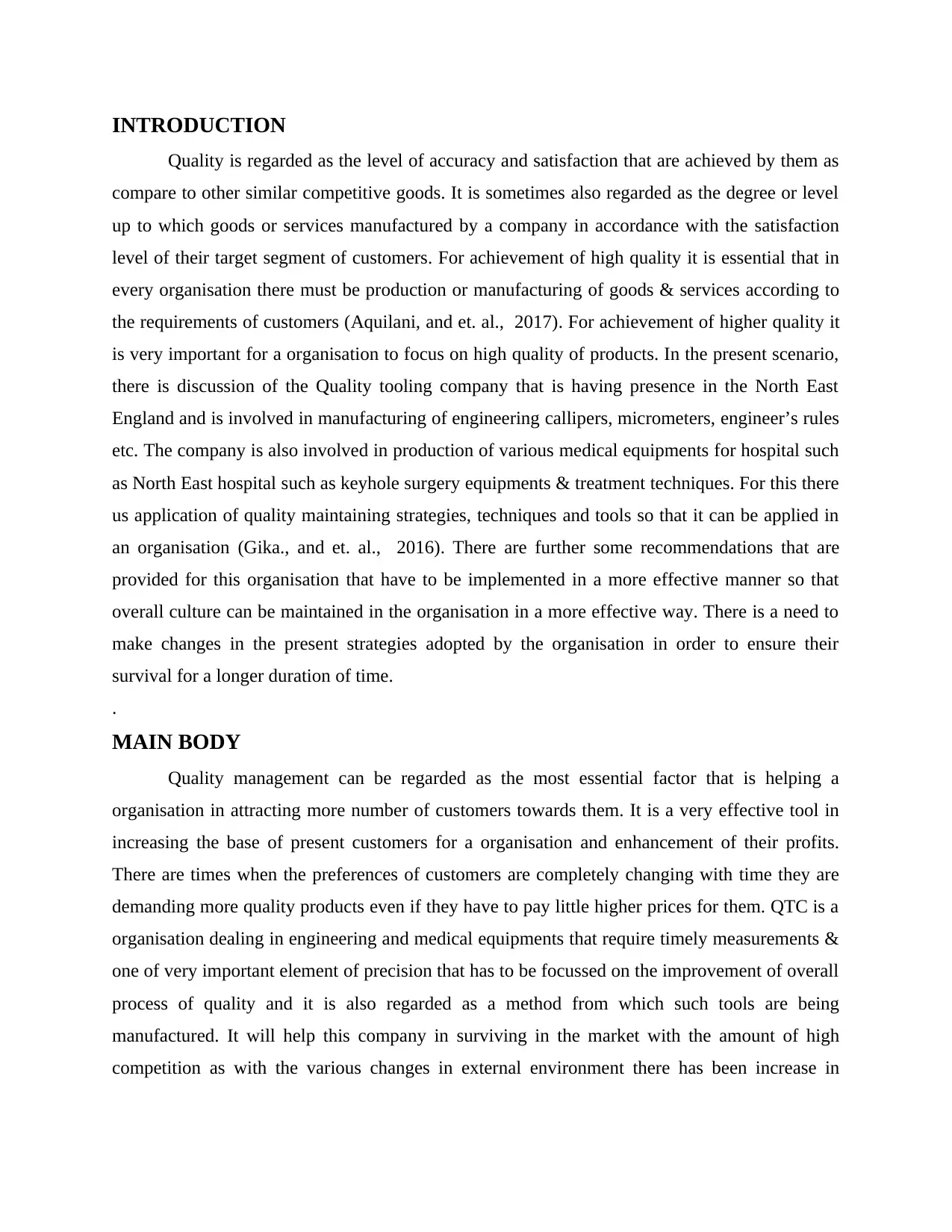
INTRODUCTION
Quality is regarded as the level of accuracy and satisfaction that are achieved by them as
compare to other similar competitive goods. It is sometimes also regarded as the degree or level
up to which goods or services manufactured by a company in accordance with the satisfaction
level of their target segment of customers. For achievement of high quality it is essential that in
every organisation there must be production or manufacturing of goods & services according to
the requirements of customers (Aquilani, and et. al., 2017). For achievement of higher quality it
is very important for a organisation to focus on high quality of products. In the present scenario,
there is discussion of the Quality tooling company that is having presence in the North East
England and is involved in manufacturing of engineering callipers, micrometers, engineer’s rules
etc. The company is also involved in production of various medical equipments for hospital such
as North East hospital such as keyhole surgery equipments & treatment techniques. For this there
us application of quality maintaining strategies, techniques and tools so that it can be applied in
an organisation (Gika., and et. al., 2016). There are further some recommendations that are
provided for this organisation that have to be implemented in a more effective manner so that
overall culture can be maintained in the organisation in a more effective way. There is a need to
make changes in the present strategies adopted by the organisation in order to ensure their
survival for a longer duration of time.
.
MAIN BODY
Quality management can be regarded as the most essential factor that is helping a
organisation in attracting more number of customers towards them. It is a very effective tool in
increasing the base of present customers for a organisation and enhancement of their profits.
There are times when the preferences of customers are completely changing with time they are
demanding more quality products even if they have to pay little higher prices for them. QTC is a
organisation dealing in engineering and medical equipments that require timely measurements &
one of very important element of precision that has to be focussed on the improvement of overall
process of quality and it is also regarded as a method from which such tools are being
manufactured. It will help this company in surviving in the market with the amount of high
competition as with the various changes in external environment there has been increase in
Quality is regarded as the level of accuracy and satisfaction that are achieved by them as
compare to other similar competitive goods. It is sometimes also regarded as the degree or level
up to which goods or services manufactured by a company in accordance with the satisfaction
level of their target segment of customers. For achievement of high quality it is essential that in
every organisation there must be production or manufacturing of goods & services according to
the requirements of customers (Aquilani, and et. al., 2017). For achievement of higher quality it
is very important for a organisation to focus on high quality of products. In the present scenario,
there is discussion of the Quality tooling company that is having presence in the North East
England and is involved in manufacturing of engineering callipers, micrometers, engineer’s rules
etc. The company is also involved in production of various medical equipments for hospital such
as North East hospital such as keyhole surgery equipments & treatment techniques. For this there
us application of quality maintaining strategies, techniques and tools so that it can be applied in
an organisation (Gika., and et. al., 2016). There are further some recommendations that are
provided for this organisation that have to be implemented in a more effective manner so that
overall culture can be maintained in the organisation in a more effective way. There is a need to
make changes in the present strategies adopted by the organisation in order to ensure their
survival for a longer duration of time.
.
MAIN BODY
Quality management can be regarded as the most essential factor that is helping a
organisation in attracting more number of customers towards them. It is a very effective tool in
increasing the base of present customers for a organisation and enhancement of their profits.
There are times when the preferences of customers are completely changing with time they are
demanding more quality products even if they have to pay little higher prices for them. QTC is a
organisation dealing in engineering and medical equipments that require timely measurements &
one of very important element of precision that has to be focussed on the improvement of overall
process of quality and it is also regarded as a method from which such tools are being
manufactured. It will help this company in surviving in the market with the amount of high
competition as with the various changes in external environment there has been increase in
⊘ This is a preview!⊘
Do you want full access?
Subscribe today to unlock all pages.

Trusted by 1+ million students worldwide
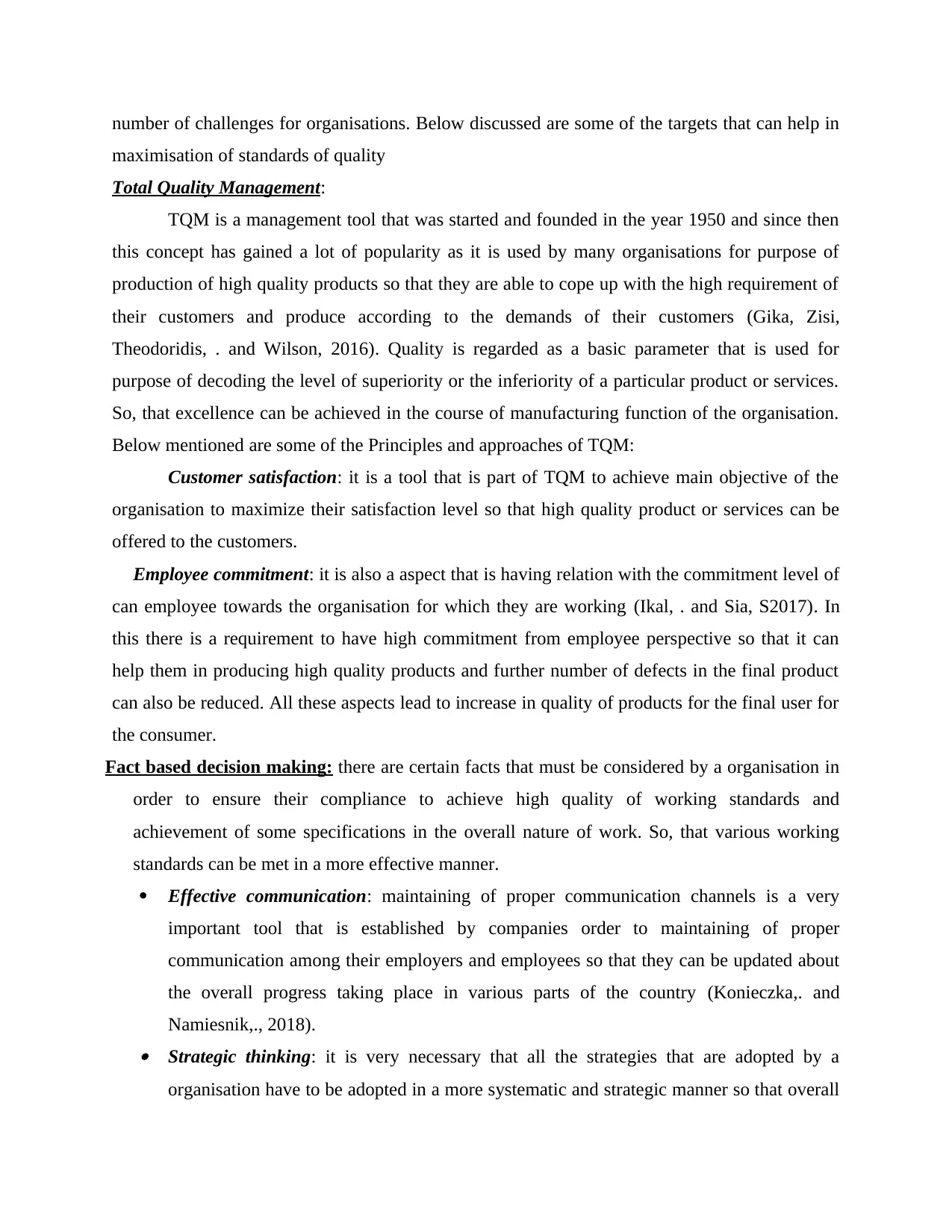
number of challenges for organisations. Below discussed are some of the targets that can help in
maximisation of standards of quality
Total Quality Management:
TQM is a management tool that was started and founded in the year 1950 and since then
this concept has gained a lot of popularity as it is used by many organisations for purpose of
production of high quality products so that they are able to cope up with the high requirement of
their customers and produce according to the demands of their customers (Gika, Zisi,
Theodoridis, . and Wilson, 2016). Quality is regarded as a basic parameter that is used for
purpose of decoding the level of superiority or the inferiority of a particular product or services.
So, that excellence can be achieved in the course of manufacturing function of the organisation.
Below mentioned are some of the Principles and approaches of TQM:
Customer satisfaction: it is a tool that is part of TQM to achieve main objective of the
organisation to maximize their satisfaction level so that high quality product or services can be
offered to the customers.
Employee commitment: it is also a aspect that is having relation with the commitment level of
can employee towards the organisation for which they are working (Ikal, . and Sia, S2017). In
this there is a requirement to have high commitment from employee perspective so that it can
help them in producing high quality products and further number of defects in the final product
can also be reduced. All these aspects lead to increase in quality of products for the final user for
the consumer.
Fact based decision making: there are certain facts that must be considered by a organisation in
order to ensure their compliance to achieve high quality of working standards and
achievement of some specifications in the overall nature of work. So, that various working
standards can be met in a more effective manner.
Effective communication: maintaining of proper communication channels is a very
important tool that is established by companies order to maintaining of proper
communication among their employers and employees so that they can be updated about
the overall progress taking place in various parts of the country (Konieczka,. and
Namiesnik,., 2018). Strategic thinking: it is very necessary that all the strategies that are adopted by a
organisation have to be adopted in a more systematic and strategic manner so that overall
maximisation of standards of quality
Total Quality Management:
TQM is a management tool that was started and founded in the year 1950 and since then
this concept has gained a lot of popularity as it is used by many organisations for purpose of
production of high quality products so that they are able to cope up with the high requirement of
their customers and produce according to the demands of their customers (Gika, Zisi,
Theodoridis, . and Wilson, 2016). Quality is regarded as a basic parameter that is used for
purpose of decoding the level of superiority or the inferiority of a particular product or services.
So, that excellence can be achieved in the course of manufacturing function of the organisation.
Below mentioned are some of the Principles and approaches of TQM:
Customer satisfaction: it is a tool that is part of TQM to achieve main objective of the
organisation to maximize their satisfaction level so that high quality product or services can be
offered to the customers.
Employee commitment: it is also a aspect that is having relation with the commitment level of
can employee towards the organisation for which they are working (Ikal, . and Sia, S2017). In
this there is a requirement to have high commitment from employee perspective so that it can
help them in producing high quality products and further number of defects in the final product
can also be reduced. All these aspects lead to increase in quality of products for the final user for
the consumer.
Fact based decision making: there are certain facts that must be considered by a organisation in
order to ensure their compliance to achieve high quality of working standards and
achievement of some specifications in the overall nature of work. So, that various working
standards can be met in a more effective manner.
Effective communication: maintaining of proper communication channels is a very
important tool that is established by companies order to maintaining of proper
communication among their employers and employees so that they can be updated about
the overall progress taking place in various parts of the country (Konieczka,. and
Namiesnik,., 2018). Strategic thinking: it is very necessary that all the strategies that are adopted by a
organisation have to be adopted in a more systematic and strategic manner so that overall
Paraphrase This Document
Need a fresh take? Get an instant paraphrase of this document with our AI Paraphraser
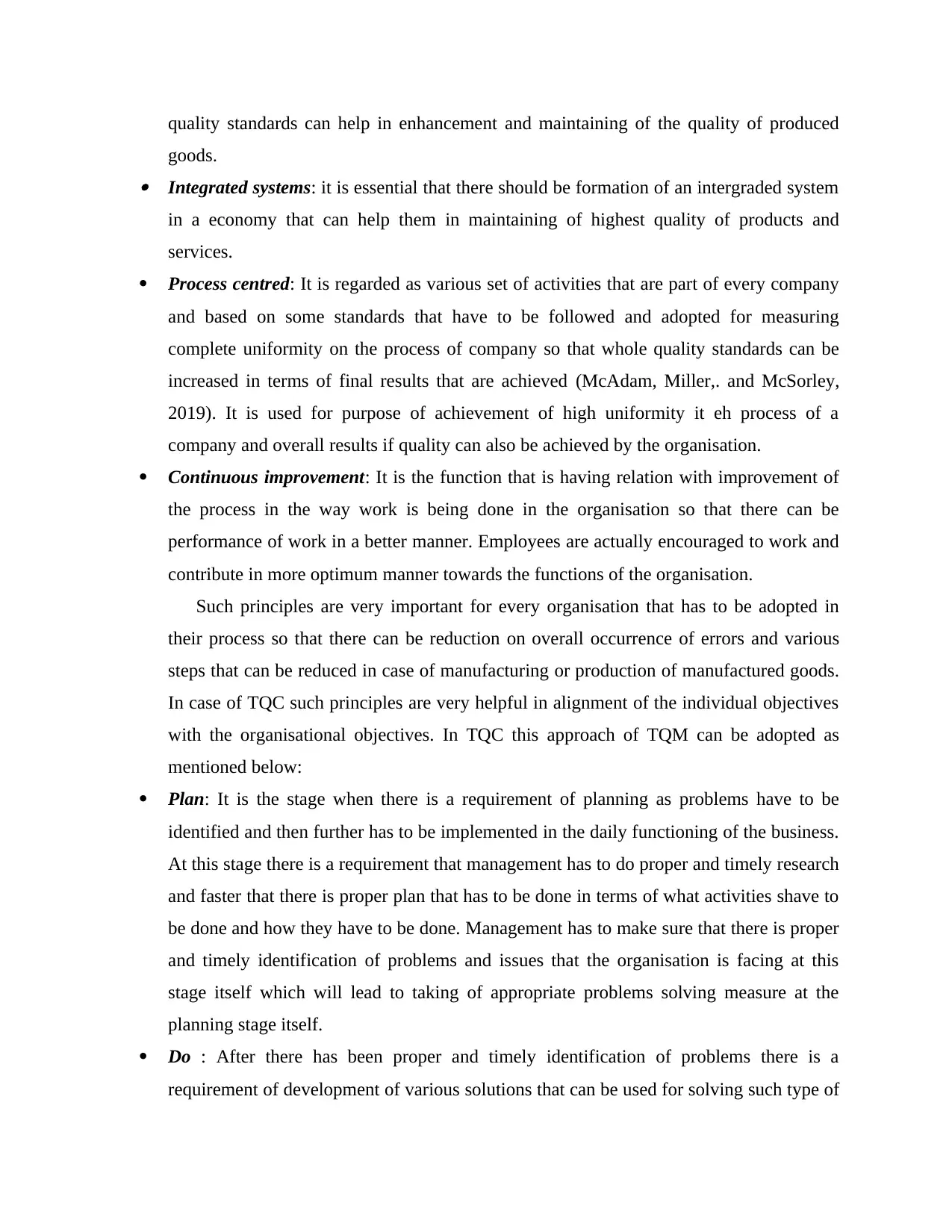
quality standards can help in enhancement and maintaining of the quality of produced
goods. Integrated systems: it is essential that there should be formation of an intergraded system
in a economy that can help them in maintaining of highest quality of products and
services.
Process centred: It is regarded as various set of activities that are part of every company
and based on some standards that have to be followed and adopted for measuring
complete uniformity on the process of company so that whole quality standards can be
increased in terms of final results that are achieved (McAdam, Miller,. and McSorley,
2019). It is used for purpose of achievement of high uniformity it eh process of a
company and overall results if quality can also be achieved by the organisation.
Continuous improvement: It is the function that is having relation with improvement of
the process in the way work is being done in the organisation so that there can be
performance of work in a better manner. Employees are actually encouraged to work and
contribute in more optimum manner towards the functions of the organisation.
Such principles are very important for every organisation that has to be adopted in
their process so that there can be reduction on overall occurrence of errors and various
steps that can be reduced in case of manufacturing or production of manufactured goods.
In case of TQC such principles are very helpful in alignment of the individual objectives
with the organisational objectives. In TQC this approach of TQM can be adopted as
mentioned below:
Plan: It is the stage when there is a requirement of planning as problems have to be
identified and then further has to be implemented in the daily functioning of the business.
At this stage there is a requirement that management has to do proper and timely research
and faster that there is proper plan that has to be done in terms of what activities shave to
be done and how they have to be done. Management has to make sure that there is proper
and timely identification of problems and issues that the organisation is facing at this
stage itself which will lead to taking of appropriate problems solving measure at the
planning stage itself.
Do : After there has been proper and timely identification of problems there is a
requirement of development of various solutions that can be used for solving such type of
goods. Integrated systems: it is essential that there should be formation of an intergraded system
in a economy that can help them in maintaining of highest quality of products and
services.
Process centred: It is regarded as various set of activities that are part of every company
and based on some standards that have to be followed and adopted for measuring
complete uniformity on the process of company so that whole quality standards can be
increased in terms of final results that are achieved (McAdam, Miller,. and McSorley,
2019). It is used for purpose of achievement of high uniformity it eh process of a
company and overall results if quality can also be achieved by the organisation.
Continuous improvement: It is the function that is having relation with improvement of
the process in the way work is being done in the organisation so that there can be
performance of work in a better manner. Employees are actually encouraged to work and
contribute in more optimum manner towards the functions of the organisation.
Such principles are very important for every organisation that has to be adopted in
their process so that there can be reduction on overall occurrence of errors and various
steps that can be reduced in case of manufacturing or production of manufactured goods.
In case of TQC such principles are very helpful in alignment of the individual objectives
with the organisational objectives. In TQC this approach of TQM can be adopted as
mentioned below:
Plan: It is the stage when there is a requirement of planning as problems have to be
identified and then further has to be implemented in the daily functioning of the business.
At this stage there is a requirement that management has to do proper and timely research
and faster that there is proper plan that has to be done in terms of what activities shave to
be done and how they have to be done. Management has to make sure that there is proper
and timely identification of problems and issues that the organisation is facing at this
stage itself which will lead to taking of appropriate problems solving measure at the
planning stage itself.
Do : After there has been proper and timely identification of problems there is a
requirement of development of various solutions that can be used for solving such type of
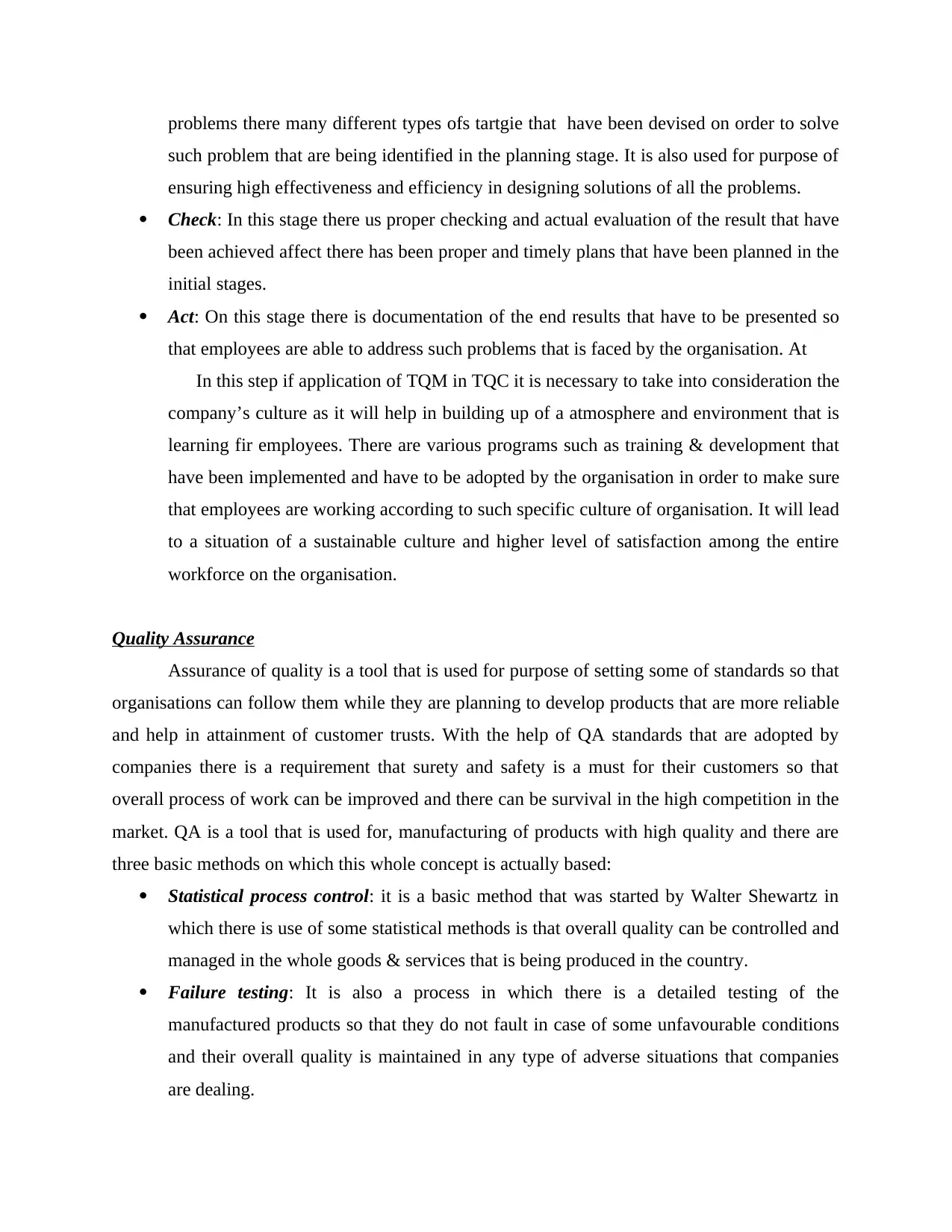
problems there many different types ofs tartgie that have been devised on order to solve
such problem that are being identified in the planning stage. It is also used for purpose of
ensuring high effectiveness and efficiency in designing solutions of all the problems.
Check: In this stage there us proper checking and actual evaluation of the result that have
been achieved affect there has been proper and timely plans that have been planned in the
initial stages.
Act: On this stage there is documentation of the end results that have to be presented so
that employees are able to address such problems that is faced by the organisation. At
In this step if application of TQM in TQC it is necessary to take into consideration the
company’s culture as it will help in building up of a atmosphere and environment that is
learning fir employees. There are various programs such as training & development that
have been implemented and have to be adopted by the organisation in order to make sure
that employees are working according to such specific culture of organisation. It will lead
to a situation of a sustainable culture and higher level of satisfaction among the entire
workforce on the organisation.
Quality Assurance
Assurance of quality is a tool that is used for purpose of setting some of standards so that
organisations can follow them while they are planning to develop products that are more reliable
and help in attainment of customer trusts. With the help of QA standards that are adopted by
companies there is a requirement that surety and safety is a must for their customers so that
overall process of work can be improved and there can be survival in the high competition in the
market. QA is a tool that is used for, manufacturing of products with high quality and there are
three basic methods on which this whole concept is actually based:
Statistical process control: it is a basic method that was started by Walter Shewartz in
which there is use of some statistical methods is that overall quality can be controlled and
managed in the whole goods & services that is being produced in the country.
Failure testing: It is also a process in which there is a detailed testing of the
manufactured products so that they do not fault in case of some unfavourable conditions
and their overall quality is maintained in any type of adverse situations that companies
are dealing.
such problem that are being identified in the planning stage. It is also used for purpose of
ensuring high effectiveness and efficiency in designing solutions of all the problems.
Check: In this stage there us proper checking and actual evaluation of the result that have
been achieved affect there has been proper and timely plans that have been planned in the
initial stages.
Act: On this stage there is documentation of the end results that have to be presented so
that employees are able to address such problems that is faced by the organisation. At
In this step if application of TQM in TQC it is necessary to take into consideration the
company’s culture as it will help in building up of a atmosphere and environment that is
learning fir employees. There are various programs such as training & development that
have been implemented and have to be adopted by the organisation in order to make sure
that employees are working according to such specific culture of organisation. It will lead
to a situation of a sustainable culture and higher level of satisfaction among the entire
workforce on the organisation.
Quality Assurance
Assurance of quality is a tool that is used for purpose of setting some of standards so that
organisations can follow them while they are planning to develop products that are more reliable
and help in attainment of customer trusts. With the help of QA standards that are adopted by
companies there is a requirement that surety and safety is a must for their customers so that
overall process of work can be improved and there can be survival in the high competition in the
market. QA is a tool that is used for, manufacturing of products with high quality and there are
three basic methods on which this whole concept is actually based:
Statistical process control: it is a basic method that was started by Walter Shewartz in
which there is use of some statistical methods is that overall quality can be controlled and
managed in the whole goods & services that is being produced in the country.
Failure testing: It is also a process in which there is a detailed testing of the
manufactured products so that they do not fault in case of some unfavourable conditions
and their overall quality is maintained in any type of adverse situations that companies
are dealing.
⊘ This is a preview!⊘
Do you want full access?
Subscribe today to unlock all pages.

Trusted by 1+ million students worldwide
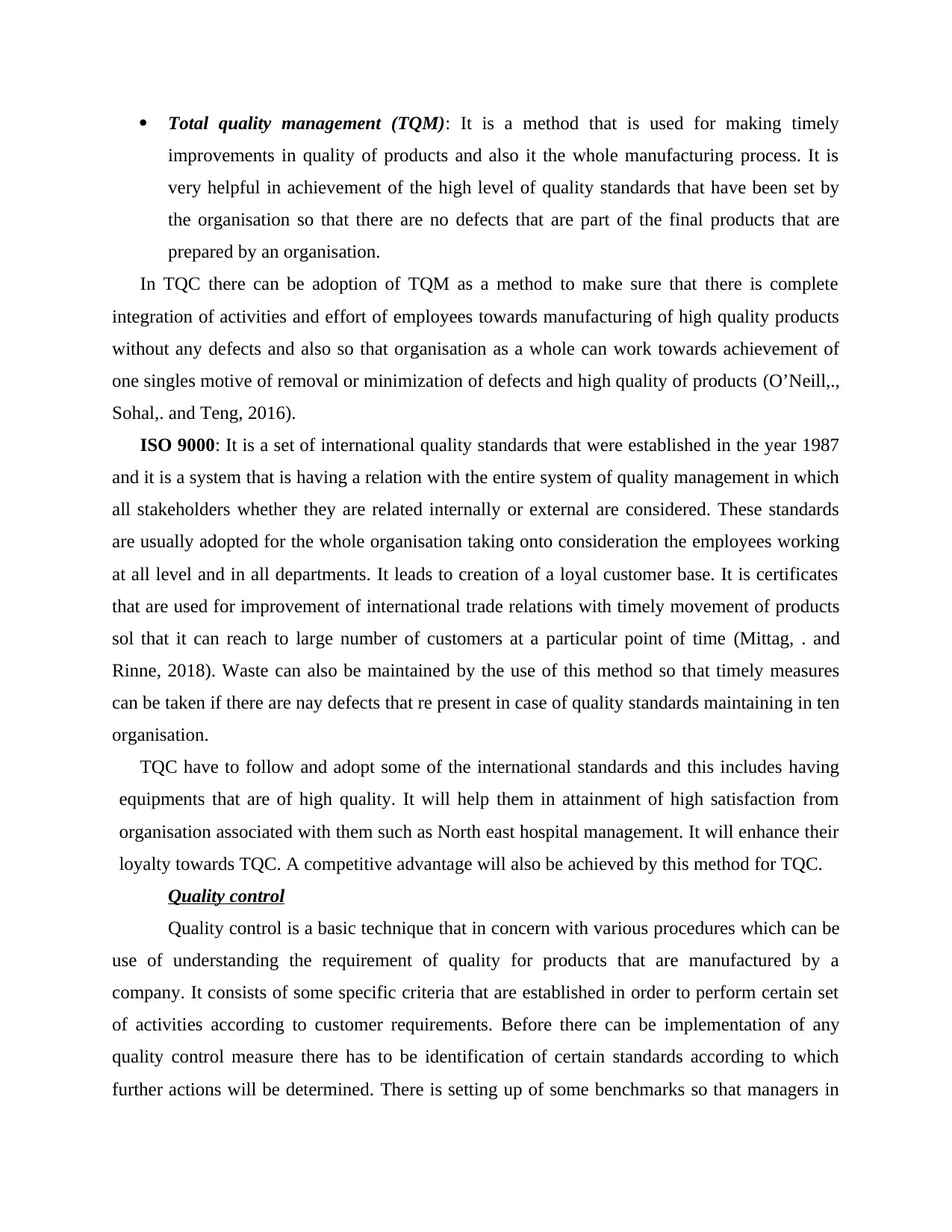
Total quality management (TQM): It is a method that is used for making timely
improvements in quality of products and also it the whole manufacturing process. It is
very helpful in achievement of the high level of quality standards that have been set by
the organisation so that there are no defects that are part of the final products that are
prepared by an organisation.
In TQC there can be adoption of TQM as a method to make sure that there is complete
integration of activities and effort of employees towards manufacturing of high quality products
without any defects and also so that organisation as a whole can work towards achievement of
one singles motive of removal or minimization of defects and high quality of products (O’Neill,.,
Sohal,. and Teng, 2016).
ISO 9000: It is a set of international quality standards that were established in the year 1987
and it is a system that is having a relation with the entire system of quality management in which
all stakeholders whether they are related internally or external are considered. These standards
are usually adopted for the whole organisation taking onto consideration the employees working
at all level and in all departments. It leads to creation of a loyal customer base. It is certificates
that are used for improvement of international trade relations with timely movement of products
sol that it can reach to large number of customers at a particular point of time (Mittag, . and
Rinne, 2018). Waste can also be maintained by the use of this method so that timely measures
can be taken if there are nay defects that re present in case of quality standards maintaining in ten
organisation.
TQC have to follow and adopt some of the international standards and this includes having
equipments that are of high quality. It will help them in attainment of high satisfaction from
organisation associated with them such as North east hospital management. It will enhance their
loyalty towards TQC. A competitive advantage will also be achieved by this method for TQC.
Quality control
Quality control is a basic technique that in concern with various procedures which can be
use of understanding the requirement of quality for products that are manufactured by a
company. It consists of some specific criteria that are established in order to perform certain set
of activities according to customer requirements. Before there can be implementation of any
quality control measure there has to be identification of certain standards according to which
further actions will be determined. There is setting up of some benchmarks so that managers in
improvements in quality of products and also it the whole manufacturing process. It is
very helpful in achievement of the high level of quality standards that have been set by
the organisation so that there are no defects that are part of the final products that are
prepared by an organisation.
In TQC there can be adoption of TQM as a method to make sure that there is complete
integration of activities and effort of employees towards manufacturing of high quality products
without any defects and also so that organisation as a whole can work towards achievement of
one singles motive of removal or minimization of defects and high quality of products (O’Neill,.,
Sohal,. and Teng, 2016).
ISO 9000: It is a set of international quality standards that were established in the year 1987
and it is a system that is having a relation with the entire system of quality management in which
all stakeholders whether they are related internally or external are considered. These standards
are usually adopted for the whole organisation taking onto consideration the employees working
at all level and in all departments. It leads to creation of a loyal customer base. It is certificates
that are used for improvement of international trade relations with timely movement of products
sol that it can reach to large number of customers at a particular point of time (Mittag, . and
Rinne, 2018). Waste can also be maintained by the use of this method so that timely measures
can be taken if there are nay defects that re present in case of quality standards maintaining in ten
organisation.
TQC have to follow and adopt some of the international standards and this includes having
equipments that are of high quality. It will help them in attainment of high satisfaction from
organisation associated with them such as North east hospital management. It will enhance their
loyalty towards TQC. A competitive advantage will also be achieved by this method for TQC.
Quality control
Quality control is a basic technique that in concern with various procedures which can be
use of understanding the requirement of quality for products that are manufactured by a
company. It consists of some specific criteria that are established in order to perform certain set
of activities according to customer requirements. Before there can be implementation of any
quality control measure there has to be identification of certain standards according to which
further actions will be determined. There is setting up of some benchmarks so that managers in
Paraphrase This Document
Need a fresh take? Get an instant paraphrase of this document with our AI Paraphraser
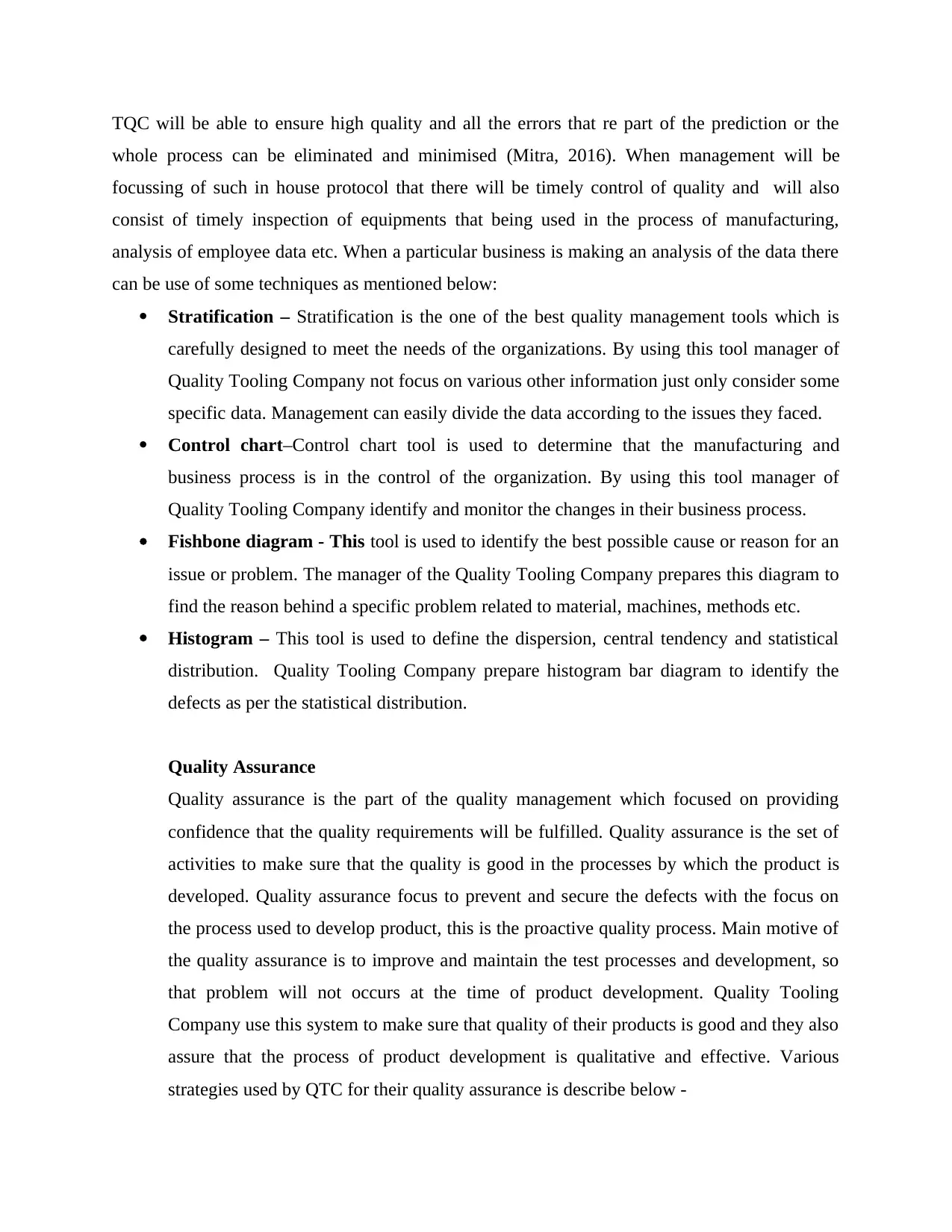
TQC will be able to ensure high quality and all the errors that re part of the prediction or the
whole process can be eliminated and minimised (Mitra, 2016). When management will be
focussing of such in house protocol that there will be timely control of quality and will also
consist of timely inspection of equipments that being used in the process of manufacturing,
analysis of employee data etc. When a particular business is making an analysis of the data there
can be use of some techniques as mentioned below:
Stratification – Stratification is the one of the best quality management tools which is
carefully designed to meet the needs of the organizations. By using this tool manager of
Quality Tooling Company not focus on various other information just only consider some
specific data. Management can easily divide the data according to the issues they faced.
Control chart–Control chart tool is used to determine that the manufacturing and
business process is in the control of the organization. By using this tool manager of
Quality Tooling Company identify and monitor the changes in their business process.
Fishbone diagram - This tool is used to identify the best possible cause or reason for an
issue or problem. The manager of the Quality Tooling Company prepares this diagram to
find the reason behind a specific problem related to material, machines, methods etc.
Histogram – This tool is used to define the dispersion, central tendency and statistical
distribution. Quality Tooling Company prepare histogram bar diagram to identify the
defects as per the statistical distribution.
Quality Assurance
Quality assurance is the part of the quality management which focused on providing
confidence that the quality requirements will be fulfilled. Quality assurance is the set of
activities to make sure that the quality is good in the processes by which the product is
developed. Quality assurance focus to prevent and secure the defects with the focus on
the process used to develop product, this is the proactive quality process. Main motive of
the quality assurance is to improve and maintain the test processes and development, so
that problem will not occurs at the time of product development. Quality Tooling
Company use this system to make sure that quality of their products is good and they also
assure that the process of product development is qualitative and effective. Various
strategies used by QTC for their quality assurance is describe below -
whole process can be eliminated and minimised (Mitra, 2016). When management will be
focussing of such in house protocol that there will be timely control of quality and will also
consist of timely inspection of equipments that being used in the process of manufacturing,
analysis of employee data etc. When a particular business is making an analysis of the data there
can be use of some techniques as mentioned below:
Stratification – Stratification is the one of the best quality management tools which is
carefully designed to meet the needs of the organizations. By using this tool manager of
Quality Tooling Company not focus on various other information just only consider some
specific data. Management can easily divide the data according to the issues they faced.
Control chart–Control chart tool is used to determine that the manufacturing and
business process is in the control of the organization. By using this tool manager of
Quality Tooling Company identify and monitor the changes in their business process.
Fishbone diagram - This tool is used to identify the best possible cause or reason for an
issue or problem. The manager of the Quality Tooling Company prepares this diagram to
find the reason behind a specific problem related to material, machines, methods etc.
Histogram – This tool is used to define the dispersion, central tendency and statistical
distribution. Quality Tooling Company prepare histogram bar diagram to identify the
defects as per the statistical distribution.
Quality Assurance
Quality assurance is the part of the quality management which focused on providing
confidence that the quality requirements will be fulfilled. Quality assurance is the set of
activities to make sure that the quality is good in the processes by which the product is
developed. Quality assurance focus to prevent and secure the defects with the focus on
the process used to develop product, this is the proactive quality process. Main motive of
the quality assurance is to improve and maintain the test processes and development, so
that problem will not occurs at the time of product development. Quality Tooling
Company use this system to make sure that quality of their products is good and they also
assure that the process of product development is qualitative and effective. Various
strategies used by QTC for their quality assurance is describe below -
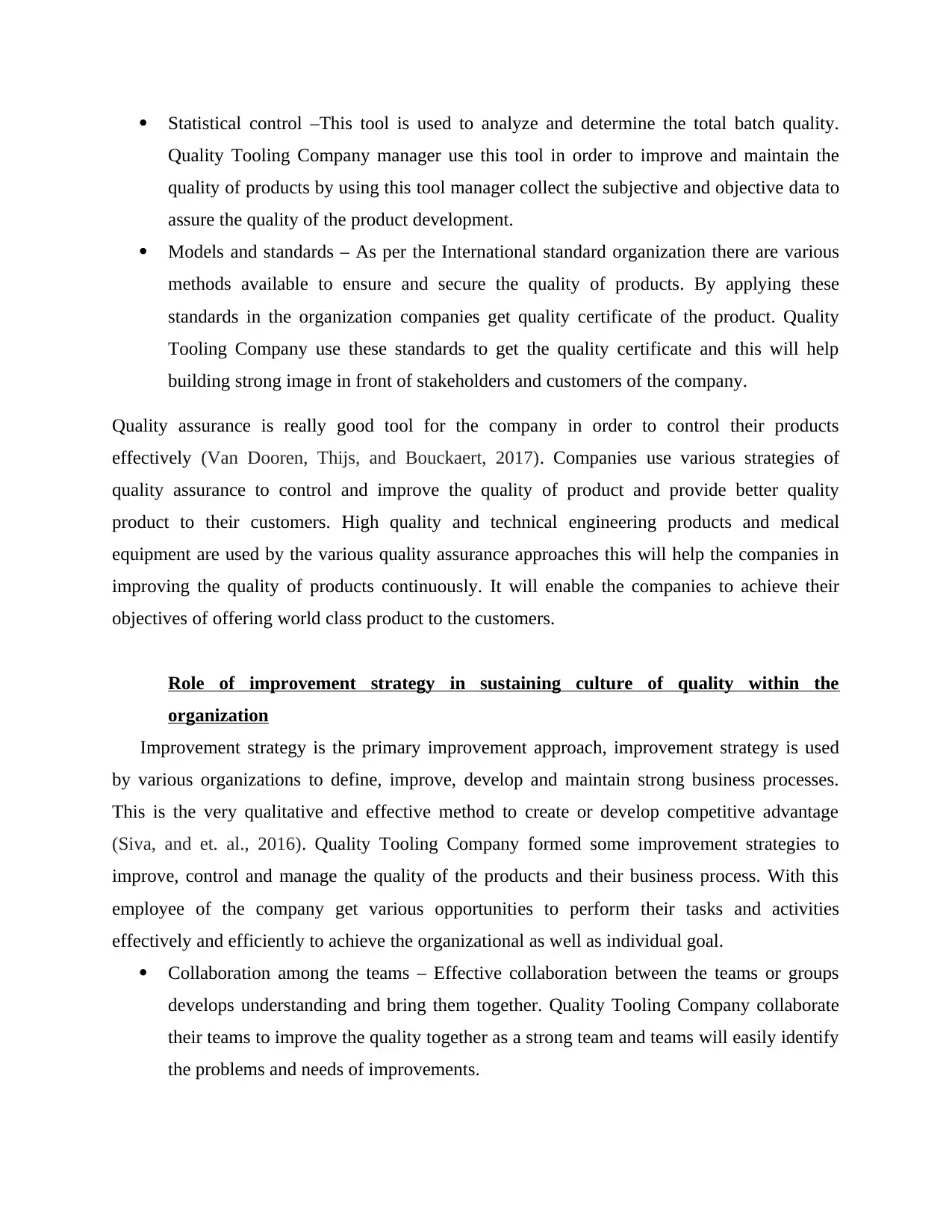
Statistical control –This tool is used to analyze and determine the total batch quality.
Quality Tooling Company manager use this tool in order to improve and maintain the
quality of products by using this tool manager collect the subjective and objective data to
assure the quality of the product development.
Models and standards – As per the International standard organization there are various
methods available to ensure and secure the quality of products. By applying these
standards in the organization companies get quality certificate of the product. Quality
Tooling Company use these standards to get the quality certificate and this will help
building strong image in front of stakeholders and customers of the company.
Quality assurance is really good tool for the company in order to control their products
effectively (Van Dooren, Thijs, and Bouckaert, 2017). Companies use various strategies of
quality assurance to control and improve the quality of product and provide better quality
product to their customers. High quality and technical engineering products and medical
equipment are used by the various quality assurance approaches this will help the companies in
improving the quality of products continuously. It will enable the companies to achieve their
objectives of offering world class product to the customers.
Role of improvement strategy in sustaining culture of quality within the
organization
Improvement strategy is the primary improvement approach, improvement strategy is used
by various organizations to define, improve, develop and maintain strong business processes.
This is the very qualitative and effective method to create or develop competitive advantage
(Siva, and et. al., 2016). Quality Tooling Company formed some improvement strategies to
improve, control and manage the quality of the products and their business process. With this
employee of the company get various opportunities to perform their tasks and activities
effectively and efficiently to achieve the organizational as well as individual goal.
Collaboration among the teams – Effective collaboration between the teams or groups
develops understanding and bring them together. Quality Tooling Company collaborate
their teams to improve the quality together as a strong team and teams will easily identify
the problems and needs of improvements.
Quality Tooling Company manager use this tool in order to improve and maintain the
quality of products by using this tool manager collect the subjective and objective data to
assure the quality of the product development.
Models and standards – As per the International standard organization there are various
methods available to ensure and secure the quality of products. By applying these
standards in the organization companies get quality certificate of the product. Quality
Tooling Company use these standards to get the quality certificate and this will help
building strong image in front of stakeholders and customers of the company.
Quality assurance is really good tool for the company in order to control their products
effectively (Van Dooren, Thijs, and Bouckaert, 2017). Companies use various strategies of
quality assurance to control and improve the quality of product and provide better quality
product to their customers. High quality and technical engineering products and medical
equipment are used by the various quality assurance approaches this will help the companies in
improving the quality of products continuously. It will enable the companies to achieve their
objectives of offering world class product to the customers.
Role of improvement strategy in sustaining culture of quality within the
organization
Improvement strategy is the primary improvement approach, improvement strategy is used
by various organizations to define, improve, develop and maintain strong business processes.
This is the very qualitative and effective method to create or develop competitive advantage
(Siva, and et. al., 2016). Quality Tooling Company formed some improvement strategies to
improve, control and manage the quality of the products and their business process. With this
employee of the company get various opportunities to perform their tasks and activities
effectively and efficiently to achieve the organizational as well as individual goal.
Collaboration among the teams – Effective collaboration between the teams or groups
develops understanding and bring them together. Quality Tooling Company collaborate
their teams to improve the quality together as a strong team and teams will easily identify
the problems and needs of improvements.
⊘ This is a preview!⊘
Do you want full access?
Subscribe today to unlock all pages.

Trusted by 1+ million students worldwide
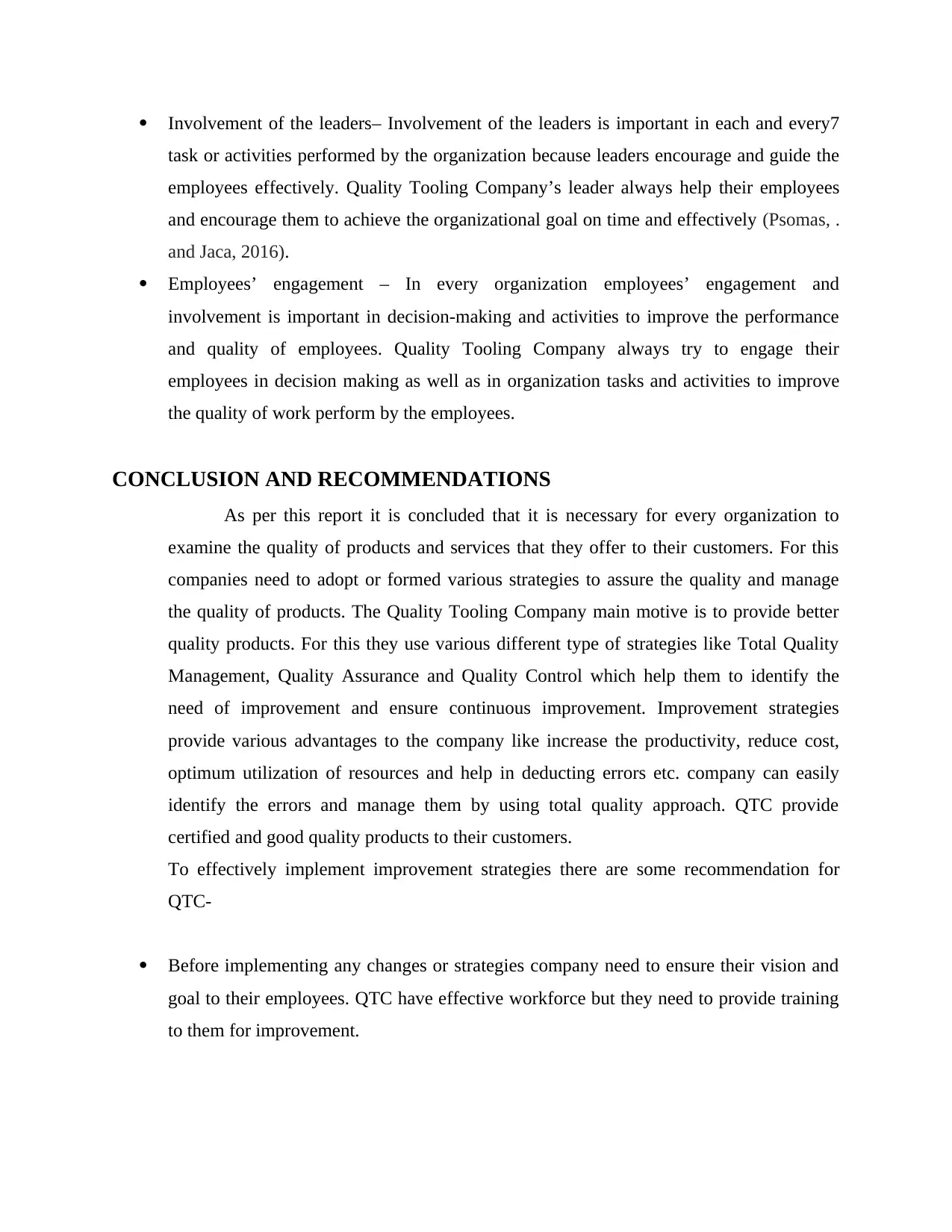
Involvement of the leaders– Involvement of the leaders is important in each and every7
task or activities performed by the organization because leaders encourage and guide the
employees effectively. Quality Tooling Company’s leader always help their employees
and encourage them to achieve the organizational goal on time and effectively (Psomas, .
and Jaca, 2016).
Employees’ engagement – In every organization employees’ engagement and
involvement is important in decision-making and activities to improve the performance
and quality of employees. Quality Tooling Company always try to engage their
employees in decision making as well as in organization tasks and activities to improve
the quality of work perform by the employees.
CONCLUSION AND RECOMMENDATIONS
As per this report it is concluded that it is necessary for every organization to
examine the quality of products and services that they offer to their customers. For this
companies need to adopt or formed various strategies to assure the quality and manage
the quality of products. The Quality Tooling Company main motive is to provide better
quality products. For this they use various different type of strategies like Total Quality
Management, Quality Assurance and Quality Control which help them to identify the
need of improvement and ensure continuous improvement. Improvement strategies
provide various advantages to the company like increase the productivity, reduce cost,
optimum utilization of resources and help in deducting errors etc. company can easily
identify the errors and manage them by using total quality approach. QTC provide
certified and good quality products to their customers.
To effectively implement improvement strategies there are some recommendation for
QTC-
Before implementing any changes or strategies company need to ensure their vision and
goal to their employees. QTC have effective workforce but they need to provide training
to them for improvement.
task or activities performed by the organization because leaders encourage and guide the
employees effectively. Quality Tooling Company’s leader always help their employees
and encourage them to achieve the organizational goal on time and effectively (Psomas, .
and Jaca, 2016).
Employees’ engagement – In every organization employees’ engagement and
involvement is important in decision-making and activities to improve the performance
and quality of employees. Quality Tooling Company always try to engage their
employees in decision making as well as in organization tasks and activities to improve
the quality of work perform by the employees.
CONCLUSION AND RECOMMENDATIONS
As per this report it is concluded that it is necessary for every organization to
examine the quality of products and services that they offer to their customers. For this
companies need to adopt or formed various strategies to assure the quality and manage
the quality of products. The Quality Tooling Company main motive is to provide better
quality products. For this they use various different type of strategies like Total Quality
Management, Quality Assurance and Quality Control which help them to identify the
need of improvement and ensure continuous improvement. Improvement strategies
provide various advantages to the company like increase the productivity, reduce cost,
optimum utilization of resources and help in deducting errors etc. company can easily
identify the errors and manage them by using total quality approach. QTC provide
certified and good quality products to their customers.
To effectively implement improvement strategies there are some recommendation for
QTC-
Before implementing any changes or strategies company need to ensure their vision and
goal to their employees. QTC have effective workforce but they need to provide training
to them for improvement.
Paraphrase This Document
Need a fresh take? Get an instant paraphrase of this document with our AI Paraphraser
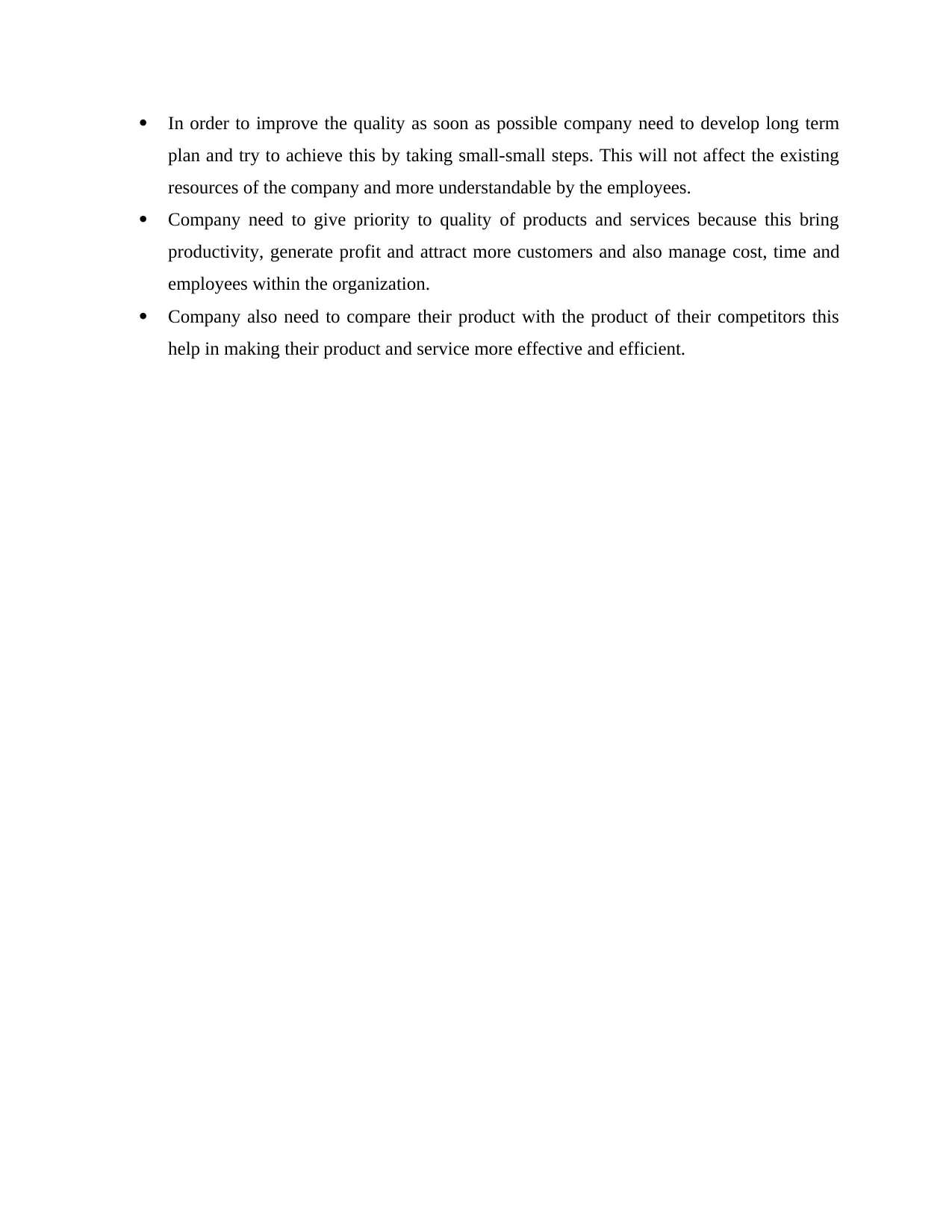
In order to improve the quality as soon as possible company need to develop long term
plan and try to achieve this by taking small-small steps. This will not affect the existing
resources of the company and more understandable by the employees.
Company need to give priority to quality of products and services because this bring
productivity, generate profit and attract more customers and also manage cost, time and
employees within the organization.
Company also need to compare their product with the product of their competitors this
help in making their product and service more effective and efficient.
plan and try to achieve this by taking small-small steps. This will not affect the existing
resources of the company and more understandable by the employees.
Company need to give priority to quality of products and services because this bring
productivity, generate profit and attract more customers and also manage cost, time and
employees within the organization.
Company also need to compare their product with the product of their competitors this
help in making their product and service more effective and efficient.
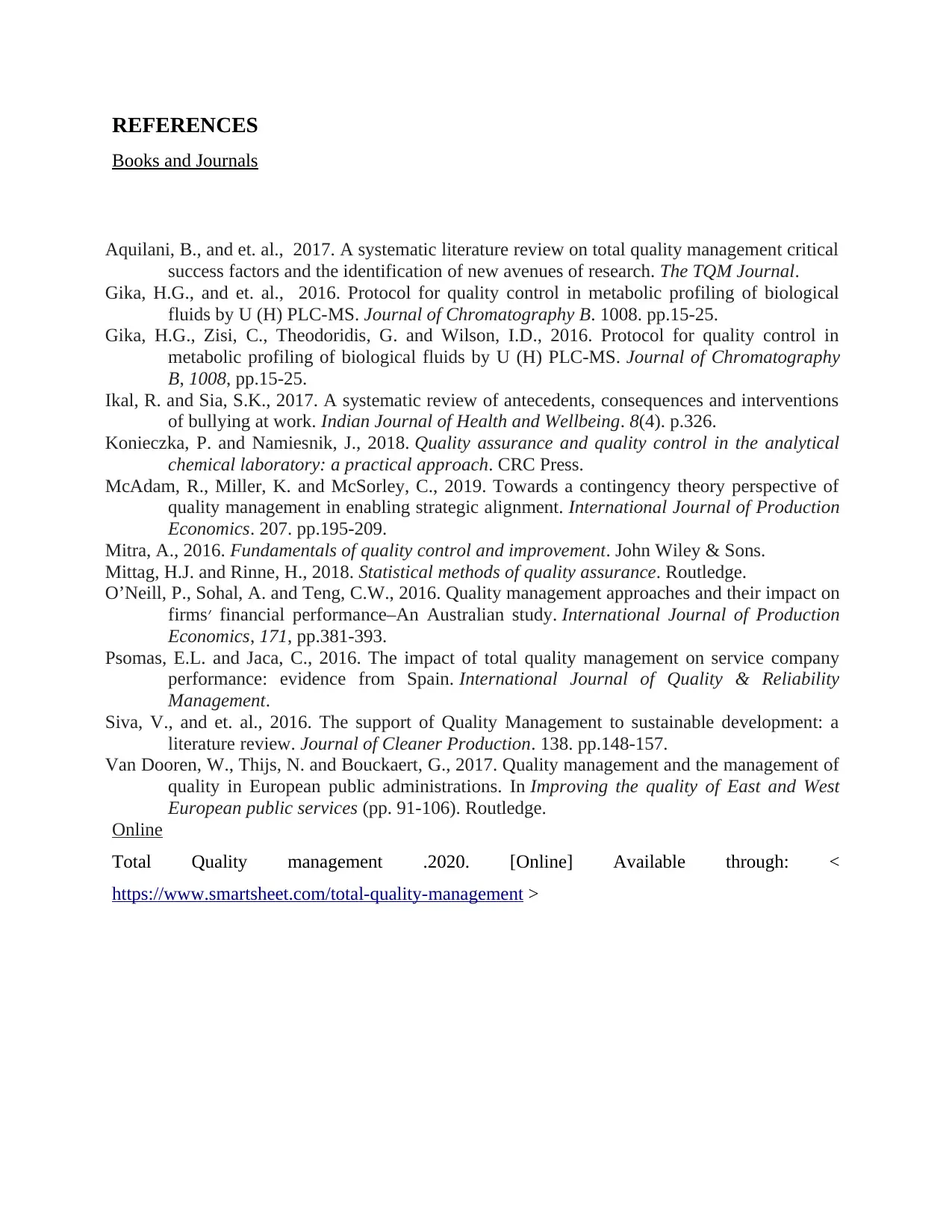
REFERENCES
Books and Journals
Aquilani, B., and et. al., 2017. A systematic literature review on total quality management critical
success factors and the identification of new avenues of research. The TQM Journal.
Gika, H.G., and et. al., 2016. Protocol for quality control in metabolic profiling of biological
fluids by U (H) PLC-MS. Journal of Chromatography B. 1008. pp.15-25.
Gika, H.G., Zisi, C., Theodoridis, G. and Wilson, I.D., 2016. Protocol for quality control in
metabolic profiling of biological fluids by U (H) PLC-MS. Journal of Chromatography
B, 1008, pp.15-25.
Ikal, R. and Sia, S.K., 2017. A systematic review of antecedents, consequences and interventions
of bullying at work. Indian Journal of Health and Wellbeing. 8(4). p.326.
Konieczka, P. and Namiesnik, J., 2018. Quality assurance and quality control in the analytical
chemical laboratory: a practical approach. CRC Press.
McAdam, R., Miller, K. and McSorley, C., 2019. Towards a contingency theory perspective of
quality management in enabling strategic alignment. International Journal of Production
Economics. 207. pp.195-209.
Mitra, A., 2016. Fundamentals of quality control and improvement. John Wiley & Sons.
Mittag, H.J. and Rinne, H., 2018. Statistical methods of quality assurance. Routledge.
O’Neill, P., Sohal, A. and Teng, C.W., 2016. Quality management approaches and their impact on
firms׳ financial performance–An Australian study. International Journal of Production
Economics, 171, pp.381-393.
Psomas, E.L. and Jaca, C., 2016. The impact of total quality management on service company
performance: evidence from Spain. International Journal of Quality & Reliability
Management.
Siva, V., and et. al., 2016. The support of Quality Management to sustainable development: a
literature review. Journal of Cleaner Production. 138. pp.148-157.
Van Dooren, W., Thijs, N. and Bouckaert, G., 2017. Quality management and the management of
quality in European public administrations. In Improving the quality of East and West
European public services (pp. 91-106). Routledge.
Online
Total Quality management .2020. [Online] Available through: <
https://www.smartsheet.com/total-quality-management >
Books and Journals
Aquilani, B., and et. al., 2017. A systematic literature review on total quality management critical
success factors and the identification of new avenues of research. The TQM Journal.
Gika, H.G., and et. al., 2016. Protocol for quality control in metabolic profiling of biological
fluids by U (H) PLC-MS. Journal of Chromatography B. 1008. pp.15-25.
Gika, H.G., Zisi, C., Theodoridis, G. and Wilson, I.D., 2016. Protocol for quality control in
metabolic profiling of biological fluids by U (H) PLC-MS. Journal of Chromatography
B, 1008, pp.15-25.
Ikal, R. and Sia, S.K., 2017. A systematic review of antecedents, consequences and interventions
of bullying at work. Indian Journal of Health and Wellbeing. 8(4). p.326.
Konieczka, P. and Namiesnik, J., 2018. Quality assurance and quality control in the analytical
chemical laboratory: a practical approach. CRC Press.
McAdam, R., Miller, K. and McSorley, C., 2019. Towards a contingency theory perspective of
quality management in enabling strategic alignment. International Journal of Production
Economics. 207. pp.195-209.
Mitra, A., 2016. Fundamentals of quality control and improvement. John Wiley & Sons.
Mittag, H.J. and Rinne, H., 2018. Statistical methods of quality assurance. Routledge.
O’Neill, P., Sohal, A. and Teng, C.W., 2016. Quality management approaches and their impact on
firms׳ financial performance–An Australian study. International Journal of Production
Economics, 171, pp.381-393.
Psomas, E.L. and Jaca, C., 2016. The impact of total quality management on service company
performance: evidence from Spain. International Journal of Quality & Reliability
Management.
Siva, V., and et. al., 2016. The support of Quality Management to sustainable development: a
literature review. Journal of Cleaner Production. 138. pp.148-157.
Van Dooren, W., Thijs, N. and Bouckaert, G., 2017. Quality management and the management of
quality in European public administrations. In Improving the quality of East and West
European public services (pp. 91-106). Routledge.
Online
Total Quality management .2020. [Online] Available through: <
https://www.smartsheet.com/total-quality-management >
⊘ This is a preview!⊘
Do you want full access?
Subscribe today to unlock all pages.

Trusted by 1+ million students worldwide
1 out of 13
Related Documents
Your All-in-One AI-Powered Toolkit for Academic Success.
+13062052269
info@desklib.com
Available 24*7 on WhatsApp / Email
![[object Object]](/_next/static/media/star-bottom.7253800d.svg)
Unlock your academic potential
Copyright © 2020–2025 A2Z Services. All Rights Reserved. Developed and managed by ZUCOL.




